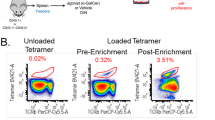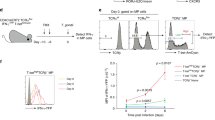Abstract
The generation of effector cytotoxic T lymphocytes from resting precursors proceeds through a series of steps in a pathway that, in aggregate, involves both proliferation and development of cytotoxicity1–7. To understand the relationship of the various signals (mitogens and/or lymphokines) that bring about progress along this pathway, it is desirable to define a series of 'minimal signals', each of which stimulates the cell to proceed to a further stage in this process of differentiation. Stimulation of lymphocytes with two different monoclonal antibodies directed against the CD2 surface molecule induces a proliferative response8; we report here that both CD4+ and CD8+ cells proliferate in response to such a stimulus but do not develop cytotoxicity. Addition of recombinant γ-interferon (rIFN-γ) or recombinant IL-2 (rIL-2) to the activated cells leads to acquisition of cytotoxic status by the CD8+ cells but not the CD4+ cells. The availability, in addition to precursors and effectors, of an apparently intermediate stage in the form of proliferating CD8+ cells that are non-cytotoxic should facilitate both cellular and molecular studies of this maturation pathway; the differences between CD4+ and CD8+ cells in development of cytotoxicity under these experimental conditions is a valuable model for understanding differentiation of T lymphocytes.
This is a preview of subscription content, access via your institution
Access options
Subscribe to this journal
Receive 51 print issues and online access
$199.00 per year
only $3.90 per issue
Buy this article
- Purchase on Springer Link
- Instant access to full article PDF
Prices may be subject to local taxes which are calculated during checkout
Similar content being viewed by others
References
Lafferty, K. J. & Cunningham, A. J. Aust. J. exp. Biol. med. Sci. 53, 27–42 (1975).
Bach, F. H., Bach, M. L. & Sondel, P. J. Nature 259, 273–281 (1976).
MacDonald, H. R. & Lees, R. K. J. Immun. 124, 1308–1313 (1980).
Teh, H. S. & Teh, S. J. Nature 285, 163–165 (1980).
Raulet, O. H. & Bevan, M. J. Nature 296, 754–757 (1982).
Wagner, H. et al. J. exp. Med. 155, 1876–1881 (1982).
Kanagawa, O. J. Immun. 131, 606–610 (1983).
Meuer, C. S. et al. Cell 36, 897–906 (1984).
Bretscher, P. & Cohn, M. Science 169, 1042–1049 (1970).
Melchers, F. & Andersson, J. Cell 37, 715–720 (1984).
Holter, W., Fischer, O., Majdic, O., Stockinger, H. & Knapp, W. J. exp. Med. 163, 654–664 (1986).
Martin, P. J. et al. J. Immun. 131, 180–185 (1983).
Siliciano, R., Pratt, J. C., Schmidt, R. E., Ritz, J. & Reinherz, E. L. Nature 317, 428–430 (1985).
Cheng, L. K. et al. Eur. J. Immun. 7, 767–770 (1986).
Orosz, C. G., Roopenian, D. C. & Bach, F. H. J. Immun. 130, 2499–2501 (1983).
Schendel, D. J. & Bach, F. H. J. exp. Med. 140, 1534–1546 (1974).
Lalande, M. E., McCutcheon, M. J. & Miller, R. G. J. exp. Med. 151, 12–19 (1980).
Ochoa, A. C., Gromo, G., Wee, S. L. & Bach, F. H. in Specificity and Function of Clonally Developing T Cells (eds Fleischer, B., Reimann, J. & Wagner, H.) 155–164 (Springer, Berlin, 1986).
Nakagawa, T., Nakagawa, N., Volkman, D. J. & Fauci, A. S. J. Immun. 136, 164–168 (1986).
Wysocki, L. J. & Sato, V. L. Proc. natn. Acad. Sci. U.S.A. 75, 2844–2848 (1978).
Gromo, G., Geller, R. L., Inverardi, L., Wee, S.-L. & Bach, F. H. J. Immun. 138, 2155–2160 (1987).
Author information
Authors and Affiliations
Rights and permissions
About this article
Cite this article
Gromo, G., Geller, R., Inverardi, L. et al. Signal requirements in the step-wise functional maturation of cytotoxic T lymphocytes. Nature 327, 424–426 (1987). https://doi.org/10.1038/327424a0
Received:
Accepted:
Issue Date:
DOI: https://doi.org/10.1038/327424a0
This article is cited by
-
Requirements for activation of CD8+Murine T cells
Immunologic Research (1994)
-
Inducible expression of granulocyte-macrophage colony-stimulating factor, tumor necrosis FACTOR-α, and INTERFERON-γ in two human cytotoxic leukemic T-cell lines
In Vitro Cellular & Developmental Biology - Animal (1992)
-
Effects of cytokines on in vitro growth of tumor-infiltrating lymphocytes obtained from human primary and metastatic liver tumors
Cancer Immunology Immunotherapy (1991)
Comments
By submitting a comment you agree to abide by our Terms and Community Guidelines. If you find something abusive or that does not comply with our terms or guidelines please flag it as inappropriate.



